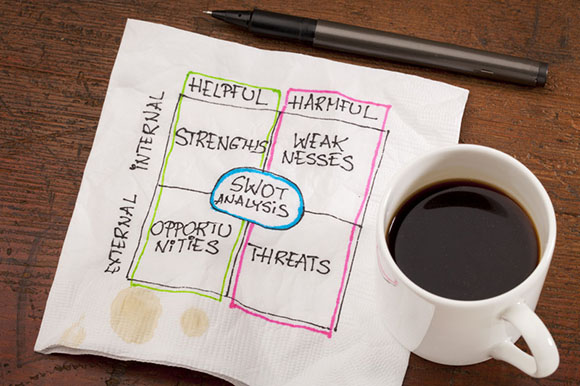
Completing a SWOT Analysis
Your "How To" Guide
SWOT links: Templates | Examples | Divisional | PowerPoint
SWOT Analysis Overview
You will find that a SWOT analysis is one of the most commonly used strategic planning techniques, however, it is also one of the most misunderstood practices.The primary use of a SWOT analysis is to provide structure to, or summarize, your strategic analysis. This technique can also be used in complex decision making, to help you to determine which of several options is better.
The Acronym SWOT represents:
- Strengths
- Weaknesses
- Opportunities
- Threats
A SWOT analysis will help you to summarize your understanding of the major issues identified in your strategic analysis. Your strategic analysis will focus on identifying the strengths, weaknesses, opportunities and threats in your three key strategic environments. Your three key strategic environments are:

The SWOT methodology is also used in decision-making, as it brings a structured analysis that can be applied to various decisions,effectively removing subjectivity and emotion from the decision-making process.
Now, let's explore Strengths, Weaknesses, Opportunities and Threats in more detail.
Strengths and Weaknesses
Strengths and weaknesses are internal to the organization and will be identified during your internal analysis.
Strength Defined:
Strength refers to a core competency of your business where your business has a competitive advantage when it comes to customer value propositions. For instance, your business scored higher than your competitor's. When completing your internal analysis, you will find that your strengths generally fall under two categories.
- Tangible Strengths: These tend to be strengths that can be precisely identified, measured or realized
- Intangible Strengths: These tend to be strengths that cannot be physically touched or physically measured
Some tangible strengths you may find in your business:
- Physical assets, including plant or facilities and equipment
- Long-term rental or business contracts
- Unique or market-leading products
- Financial resources to fund change or change management of your business
- Competitive cost advantages
- Advanced technologies or information systems
- High volume business production
- Scalability of business or products
Some intangible strengths you may find in your business:
- Brand or product recognition
- Business reputation—Are you a market leader in your industry?
- Goodwill and customer relationship management
- Business/Supplier relationships
- Strong employee relationships
- Strategic business alliances or partnerships
- Intellectual property rights or patents
- Advertising strategy or process
- Level of experience in your field
- Level of management experience in your workforce
- Industry knowledge superiority
- Industry associations that give competitive advantage
- Innovative practices within your business
Weaknesses Defined:
A weakness refers to a core competency of your business where your competitor has a competitive advantage when it comes to customer value propositions.For instance, your business scored lower than your competitor's.When completing your internal analysis, you will find that your weaknesses generally fall under two categories
- Tangible Weaknesses: These tend to be weaknesses that can be precisely identified, measured or realized
- Intangible Weaknesses: These tend to be weaknesses that cannot be physically touched or physically measured
Some tangible weaknesses you may find in your business:
- Old or outdated plant and equipment
- Narrow product line
- Insufficient financial resources to fund necessary changes
- High operating costs
- Inferior technology
- Low volume and restricted scalability
Some intangible weaknesses you may find in your business:
- Weak or unrecognizable brand
- Weak or unrecognizable image
- Poor relationships with your customers
- Poor relationships with your suppliers
- Poor relationships with your employees
- Marketing failing to meet objectives
- Manager inexperience
- Ineffective Research & Development
- Insufficient industry knowledge
- Meagre innovative skills
A voice of experience, consider the following:
It is possible that every business in an industry could identify their customer service as a strength. It might be true that all businesses in an industry have effective customer service. However, if your customers don't notice a competitive difference or advantage within your business, it is not a strength.
The strategic analysis is often completed by the leaders in the organization who put "Leadership" down as a strength.
No matter how good your business is at something; if you are not better than your competitors, you should not list it as a strength.
Opportunities and Threats
Opportunities and Threats are external to your organization and will be identified in your macro and industry environment analysis.
Given that your opportunities and threats come from your macro and industry environment, it is possible that all businesses in your industry could identify similar opportunities and threats.
You should refer to your macro environment analysis and industry environment analysis, (Porter's Five Forces) to help you to identify your opportunities and threats. Alternatively, you can use one of our SWOT templates.
Opportunity defined:
- An opportunity is an environmental condition in your macro or industry environments that can improve your organization's competitive position relative to that of your competitors.When completing your analysis, you will find that your opportunities generally fall under two categories.
Industry Opportunities: Industry opportunities are opportunities in your industry environment and generally reduce the level of price competition in your industry. To discover more about your industry environment, see Porter's Five Forces.
Macro Opportunities: Macro opportunities are in the broader environment that generally impacts all businesses in your region. To discover more about your broader environment discover your macro environment analysis.
Some possible Industry Opportunities are:
- Expansion of your product range
- Diversification of your business interests
- Growth in your customer's field (Forward Integration)
- Growth in your supplier's field (Backward integration)
- Expansion of your customer base (Geographically or through new products)
- Placid competition
- Export opportunities
- Products or service growth
Some possible Macro Opportunities are:
- Favourable changes to legislation
- Favourable changes to any import/export constraints
- Favourable economic outlook
- Favourable cultural shifts
- Technology that your business can embrace and utilize, such as Ecommerce or Internet sales
Threat Defined:
A threat is a forecasted environmental condition that is out of your control and has the potential to harm your business' profitability. You will find your threats when completing your industry environment analysis and your macro environment analysis. You will find that your threats will fit into two categories.
- Industry threats Industry threats are related to an increase in the competition in your industry or a reduction in market size. Generally, industry threats impend to reduce your business' profitability.
- Macro Threats Macro threats affect all industries in your region. These also generally result in a risk of reduced profitability.
A common example: If you import goods for resale, then a negative shift in exchange rates will driveup your costs. If you are unable to pass these costs on to your customers, your profitability margins will shrink. So, exchange rate volatility could be a threat.
Some possible Industry Threats include:
- Low cost imports: The threat of low-cost imports affects almost any manufacturer in the developed world, with the possible exception of food manufacturing.
- Consumer ability to shift to a substitute product and changing demand for substitute products
Consider the manufacture of nails used in the assembly of house frames. If housing developers shifted from timber frames to steel framed houses, demand for nails would drop significantly. - Slow market growth or decline in market size:For western countries, the demand for alcoholic beverages remains pretty flat.
- Shifts in customer or supplier buying power: Reduced margins and consolidation in the retail industry have shifted the buying power to the retailer who can bid out suppliers under high cost pressure for generic products.
- The changing needs of buyers (customers):Take the McDonalds fast food chain for example. In Australia, McDonalds faced the threat of healthier consumable goods. In response to this threat, McDonalds introduced several healthier options to their menu.
Some possible Macro Threats include:
- Shifts in foreign exchange rates that impact imports or exports: International tourism is often hit hardest by shifts in exchange rates. As currency increases in value, you will have fewer tourists visiting you, and more people in your country will seek more affordable holidays overseas. A strong currency has a double impact, fewer international travellers and fewer domestic tourists.
- Demographic changes: The aging workforce makesit difficult to hire skilled workers in many developed countries.
- Industry Regulations: A good example is aged care facilities that are impacted by increasing regulations and increased costs needed to administer these new regulations.
SWOT Analysis Tip - When an opportunity is not an opportunity
The opportunity section of the SWOT Analysis is the most commonly misunderstood, Many people use the opportunity section to list solutions to their weaknesses and threats.
- For Example: "we have an opportunity to improve employee retention" is really a weakness "Poor Employee Retention or High Employee Turnover"
The SWOT analysis is purely an analysis tool. It should contain independently verifiable statements of fact. In the macro and industry analysis, you may identify opportunities that look like solutions, however, you should only include the statement of facts.
- For Example: Instead of listing an opportunity, "We could promote a new environmentally-friendly range" you could put, "There is a shift in consumer buying patterns towards more expensive but environmentally friendly brands." This second statement is an independently verifiable statement of fact.
The reason for this is that, during your strategic analysis, you have not yet made any decisions. Decision-making comes after you have completed your SWOT and developed options for actions. Then you will make your solution decisions.
As a purist I would advise you that a SWOT is an analysis tool, and to avoid jumping to solutions. If you are more comfortable with jumping to solutions, it is your SWOT and you may do what you desire.
Note: Your SWOT analysis will be completed prior to developing your strategy or your action plans.
How to complete a SWOT analysis
There are two commonly used methods of completing a SWOT analysis.
- Brainstorming activities
- Strategic analysis summary
If you are going to use the SWOT technique during a brainstorming exercise, you should have a series of prepared questions or prompters ready to ensure that you consider the most common areas of analysis. These questions can be found in our SWOT analysis template. To access, click here
If you are keen to use the SWOT technique to summarize a more extensive strategic analysis, then you may want to review the following sections of this website to gain an understanding of this analysis.
Discover more about completing a SWOT analysis through these helpful links:
- SWOT Templates
- SWOT Examples
- SWOT PowerPoint
- SWOT Tips – Check out these articles!
- SWOT—Now What
- The challenges for a department in a large organization
SWOT in Investopedia, and
Toolshero for additional management resources